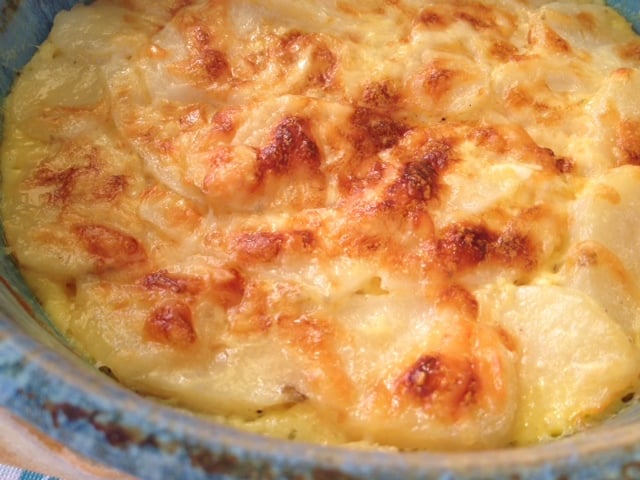Cool crisp days and chilly nights evoke a yearning for rib-sticking comfort foods. Few things are more satisfying than a succulent, rich dish of layered potatoes, cream, and cheese. This week, I was fortunate enough to get a hold of some freshly dug sunchokes, so I thought I would prepare a unique twist on a French classic.
Sunchokes, also known as Jerusalem artichokes, are somewhat elusive to the average home cook. The knobby tuber is a member of the daisy family and looks similar to ginger. The roots have a mild but distinct flavor that is somewhat nutty and slightly sweet, which I can only describe as a combination of water chestnut and artichoke heart.
One uncommon characteristic of the sunchoke is its high levels of inulin, a soluble dietary fiber that is not digested or absorbed, but rather goes straight to the bowel, where it meets, and subsequently feeds, our intestinal flora. In simpler terms, it is a prebiotic food, a supplement to encourage the prosperity of healthy bacteria in our gut. In simpler terms, it is a prebiotic food, a supplement to help feed the healthy bacteria in our gut. However, you may want to take things slow when introducing an inulin-rich food to your diet. The very thing that assists in lowering cholesterol and promoting gut flora can cause indigestion in some people, especially those that aren’t used to such high levels of fiber. If in doubt, you may substitute half the sunchokes in the recipe below for an equal amount of potatoes, yams, or other root vegetable.
Ingredients
Serves 4–6
2 pounds sunchokes (try to find larger specimens that are not too knobby, for ease of peeling)
1 1/2 cups milk
1 cup cream, crème fraiche, or mascarpone
1 bay leaf
1 clove garlic, smashed with the side of a knife
1 egg
1/2 tablespoon Dijon mustard
1 pinch nutmeg
Salt and pepper
4 ounces grated Gruyère or other flavorful cheese
1 tablespoon butter
Method
1. Preheat the oven to 350 F. Rub a 2-quart baking dish with butter, and set aside.
2. Peel the sunchokes, dropping them in a bowl of cold water as you go so they don‘t brown. Slice thinly, using a knife, mandolin, or food processor. Return slices to the cold water while you prepare the cream mixture.
3. Bring milk, cream, garlic, and bay leaf to a low boil. Remove from heat, and cover. Steep for about 10 minutes, or until cooled to warm, stirring occasionally. Remove bay leaf and garlic. Whisk in Dijon, egg and nutmeg. Season with salt and pepper.
4. Spread sunchoke slices in a single layer in the baking dish. Season with salt and pepper, then drizzle with some of the cream mixture. Sprinkle with about 1/3 of the cheese. Repeat the layers of sunchoke, cream, and cheese, until all the sunchokes have been used up, about three layers total. Pour in any remaining cream mixture.
5. Bake until bubbling and deeply browned, testing sunchokes with a knife to assure they are done (knife should slide in easily, like a potato). Let rest for 5 minutes before serving.
AUTHOR’S NOTE
To choose your organically grown and fresh ingredients wisely, use the following criteria:
·chemical- and hormone-free meat
·wild-caught fish
·pastured-raised, organic eggs
·whole, unrefined grains
·virgin, unrefined, first-press organic oils
·whole-food, unrefined sweeteners
·pure, clean, spring water
·sea salt
·raw and/or cultured milk and cream products


